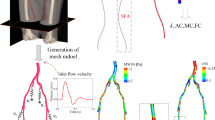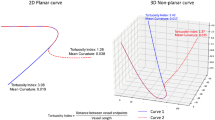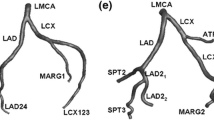Abstract
Earlier studies have demonstrated a correlation between tortuosity and atherosclerosis in the femoral artery. One conceivable explanation is that atherosclerosis causes an elongation of the artery, resulting in vessel tortuosity; another is that blood flow phenomena (such as flow separation) due to the vessel geometry may affect the progression of atherosclerosis. To determine which of these hypotheses is most likely, a group of 232 hyperlipidemic patients was followed with angiography for 3 years during lipid-lowering treatment. After digitization of the films, a tortuosity value and an atherosclerosis measure (edge roughness) were computed. In the group with lower tortuosity values, there was a significant (p<0.0001) decrease in edge roughness, but not in the group with a higher tortuosity values. On the other hand, neither the group with higher edge roughness values nor that with lower edge roughness values displayed a significant change in tortuosity. When tortuosity, roughness, and treatment were studied simultaneously, only the effect of tortuosity on roughness change was significant. These findings are more consistent with tortuosity influencing the development of atherosclerosis than with its being a consequence of atherosclerosis.
Similar content being viewed by others
References
Bergstrand, L., A. Olsson, U. Erikson, I. Holme, J. Johansson, L. Kaijser, C. Mögaard, S. Nilsson, G. Stenport, and G. Walldius. The relation of coronary and peripheral arterial disease to severity of femoral atherosclerosis in hypercholesteroleamia.J. Intern. Med. 236:367–375, 1994.
Brinkman, A., P. Baker, W. Newman, R. Vigorito, and M. Friedman. Variability of human coronary artery geometry: An angiographic study of the left anterior descending arteries of 30 autopsy hearts.Ann. Biomed. Eng. 22:34–44, 1994.
Caro, C. G., J. M. Fitz-Gerald, and R. C. Schroter. Atheroma and arterial wall shear. Observation, correlation and proposal of a shear dependent mass transfer mechanism for atherogenesis.Proc. R. Soc. Lond. B 177:109–159, 1971.
Cavalcanti, S., Flow patterns and wall shear stress in a mildly stenosed femoral artery. In: Third International Symposium on Biofluid Mechanics. Munich: VDI Verlag, 1994. pp. 613–618.
Chilvers, A. S., M. L. Thomas, and N. L. Browse. The progression of atherosclerosis: A radiologic study.Circulation 50:402–408, 1974.
Crawford, D. W., S. H. Brooks, R. H. Selzer, R. Barndt, E. S. Beckenbach, and D. H. Blankenhorn. Computer densitometry for angiographic assessment of arterial cholesterol content and gross pathology in human atherosclerosis.J. Lab. Clin. Med. 89:378–392, 1977.
Fox, B., and W. A. Seed. Location of early atheroma in the human coronary arteries.ASME J. Biomech. Eng. 103:208–212, 1981.
Friedman, M. H., and O. J. Deters. Correlation among shear rate measures in vascular flows.ASME J. Biomech. Eng. 109:25–26, 1987.
Friedman, M. H., O. J. Deters, F. F. Mark, C. B. Bargeron, and G. M. Hutchins. Arterial geometry affects hemodynamics. A potential risk factor for atherosclerosis.Atherosclerosis 46:225–231, 1983.
Friedman, M. H., G. M. Hutchins, C. B. Bargeron, O. J. Deters, and F. F. Mark. Correlation between intimal thickness and fluid shear in human arteries.Atherosclerosis 39: 425–436, 1981.
Ku, D. N., D. P. Giddens, C. K. Zarins, and S. Glagov. Pulsatile flow and atherosclerosis in the human carotid bifurcation. Positive correlation between plaque location and low and oscillating shear stress.Arteriosclerosis 5:293–302, 1985.
Newman, D., and C. Wenn. Arterial tortuosity. In: International Symposium of the Role of Blood Flow in Atherogenesis. Tokyo: Springer Verlag, 1988, pp. P25-P28.
Nilsson, S., and U. Erikson. Changes in atheroma volume estimated from digitized femoral arteriograms.Acta Radiol. 31:249–257, 1990.
Sabbah, H. N., F. Khaja, E. T. Hawkins, J. F. Brymer, T. M. McFarland, J. v.d. Bel-Kahn, P. T. Doerger, and P. D. Stein. Relation of atherosclerosis to arterial wall shear in the left anterior descending coronary artery of man.Am. Heart J. 112:453–458, 1986.
Smedby, Ö., L. Fuchs, and N. Tillmark, Separated flow demonstrated by digitized cineangiography compared with LDV.J. Biomech. Eng. 113:336–341, 1991.
Smedby, Ö., N. Högman, S. Nilsson, U. Erikson, A. G. Olsson, and G. Walldius. Two-dimensional tortuosity of the superficial femoral artery in early atherosclerosis.J. Vasc. Res. 30:181–191, 1993.
Smedby, Ö., J. Johansson, J. Mölgaard, A. G. Olsson, G. Walldius, and U. Erikson. Predilection of atherosclerosis for the inner curvature in the femoral artery—a digitized angiography study.Arterioscler. Thromb. Vasc. Biol. 15: 912–917, 1995.
Smedby, Ö., S. Nilsson, and L. Bergstrand. Development of femoral atherosclerosis in relation to flow disturbances.J. Biomech. 29:543–547, 1996.
Tjøtta, E. The distribution of atheromatosis in the coronary arteries.J. Atheroscler. Res. 3:253–261, 1963.
Walldius, G., U. Erikson, A. G. Olsson, L. Bergstrand, K. H»del, J. Johansson, J. Kaijser, C. Lassvik, J. Mölgaard, S. Nilsson, L. Schäfer-Elinder, G. Lassvik, I. Holme. The effect of probucol on femoral atherosclerosis. The Probucol Quantitative Regression Swedish Trial (PQRST).Am. J. Cardiol. 74:875–883, 1994.
Willis, G. C. Localizing factors in atherosclerosis.Can. Med. Assoc. J. 70:1–9, 1954.
Yamaguchi, T., and S. Hanai. To what extent does a minimal atherosclerotic plaque alter the arterial wall shear stress distribution? A model study by an electrochemical method.Biorheology 25:31–36, 1988.
Author information
Authors and Affiliations
Rights and permissions
About this article
Cite this article
Smedby, Ö., Bergstrand, L. Tortuosity and atherosclerosis in the femoral artery: What is cause and what is effect?. Ann Biomed Eng 24, 474–480 (1996). https://doi.org/10.1007/BF02648109
Received:
Accepted:
Issue Date:
DOI: https://doi.org/10.1007/BF02648109




